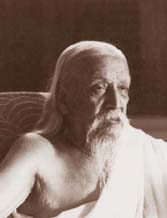
To find one’s inner truth, to change oneself, to realise the Divine, to work for a more harmonious world is not an easy task. Yet, it has to be done. This is the reason of our birth, the purpose of existence, the only thing which gives value to life and can really satisfy.
But, when one sets out on the path, the path of sadhana, one finds out how difficult it is. One’s own nature stands obstinately in the way, everything around seems to conspire against this progress and transformation, a stage comes when the seeker feels it cannot be done, it is an impossible task. One loses all hope. The question naturally arises:
Question : Is the yoga at all possible for everyone? What is its central process? What is the secret of sadhana?
Sri Aurobindo in a most beautiful and reassuring reply says that the secret is to truly want the Divine, to surrender oneself completely and to hand over the entire responsibility of one’s life and sadhana to the Divine, and then the Divine will do everything.
The Central Process of Yoga
If one wanted the Divine, the Divine himself would take up the purifying of the heart and develop the sadhana and give the necessary experiences; it can and does happen in that way if one has trust and confidence in the Divine and the will to surrender. For such a taking up involves one’s putting oneself in the hands of the Divine rather than relying on one’s own efforts alone and this implies one’s putting one’s trust and confidence in the Divine and a progressive self-giving. It is in fact the principle of sadhana that I myself followed and it is the central process of yoga as I envisage it. It is, I suppose, what Sri Ramakrishna meant by the method of the baby-cat in his image. But all cannot follow that at once; it takes time for them to arrive at it—it grows most when the mind and vital fall quiet.
What I mean by surrender is this inner surrender of the mind and vital. There is, of course, the outer surrender also: the giving up of all that is found to conflict with the spirit or need of the sadhana, the offering, the obedience to the guidance of the Divine, whether directly, if one has reached that stage, or through the psychic or to the guidance of the Guru. I may say that prayopavesana (fasting for a long time) has not anything to do with surrender: it is a form of tapasya of a very austere and, in my opinion, very excessive kind, often dangerous.
The Core of the Inner Surrender
The core of the inner surrender is trust and confidence in the Divine. One takes the attitude: “I want the Divine and nothing else. I want to give myself entirely to him and since my soul wants that, it cannot be but that I shall meet and realise him. I ask nothing but that and his action in me to bring me to him, his action secret or open, veiled or manifest. I do not insist on my own time and way; let him do all in his own time and way; I shall believe in him, accept his will, aspire steadily for his light and presence and joy, go through all difficulties and delays, relying on him and never giving up. Let my mind be quiet and trust him and let him open it to his light; let my vital be quiet and turn to him alone and let him open it to his calm and joy. All for him and myself for him. Whatever happens, I will keep to this aspiration and self-giving and go on in perfect reliance that it will be done.”
That is the attitude into which one must grow; for certainly it cannot be made perfect at once—mental and vital movements come across—but if one keeps the will to it, it will grow in the being. The rest is a matter of obedience to the guidance when it makes itself manifest, not allowing one’s mental and vital movements to interfere.
All can be done by the Divine
It is not my intention to say that this way is the only way and sadhana cannot be done otherwise—there are so many others by which one can approach the Divine. But this is the only one I know by which the taking up of sadhana by the Divine becomes a sensible fact before the preparation of the nature is done. In other methods the Divine action may be felt from time to time, but it remains mostly behind the veil till all is ready. In some sadhanas the divine action is not recognised: all must be done by tapasya. In most there is a mixing of the two: the tapasya finally calling the direct help and intervention. The idea and experience of the Divine doing all belong to the yoga based on surrender. But whatever way is followed, the one thing to be done is to be faithful and go on to the end.
All can be done by the Divine,—the heart and nature purified, the inner consciousness awakened, the veils removed,—if one gives oneself to the Divine with trust and confidence and even if one cannot do so fully at once, yet the more one does so, the more the inner help and guidance come and the experience of the Divine grows within. If the questioning mind becomes less active and humility and the will to surrender grow, this ought to be perfectly possible. No other strength and tapasya are then needed, but this alone.”
– Sri Aurobindo





